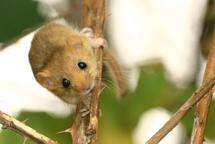Report reveals rabbit and dormouse threatening Britain's wildlife

(PhysOrg.com) -- The Easter Bunny may have been a welcome visitor to many gardens at the weekend, but his fellow rabbits are among 14 invasive species threatening Britain?s wildlife, a report by Oxford University academics has found.
The report, entitled ‘State of Britain’s Mammals’, was written by Professor David Macdonald and Dr Dawn Burnham from the Department of Zoology’s Wildlife Conservation Research Unit (WildCRU).
The study identified 14 invasive mammal species, including the traditionally popular house mice, brown hares, grey squirrels and fallow deer, which are damaging Britain’s natural habitat.
Other invaders highlighted were ferrets, muntiac deer, Japanese sika deer, Chinese water deer, edible dormice, brown and black rats, American mink and red-necked wallabies.
Most were deliberately brought to Britain for aesthetic, economic or scientific reasons.
The rabbit was first introduced by the Romans for its meat and fur, while the American mink was imported from North America to stock the British fur trade in the 20th century.
The report identified rabbits as a threat to agriculture and native species, and American mink as a danger to the existence of water voles, which are already one of the country’s most endangered species.
The study found that the arrival of non-native species can lead to predation of native species; competition for their food and habitat; the spread of disease to wildlife, livestock and humans; cross-breeding and damage to eco-systems.
Non-native species are estimated to cost the British economy at least £3bn a year in management and control.
Professor David Macdonald, the report’s author, warned that the public’s emotional attachment to some of the invading species contributes to conservation problems.
Many people find the acrobatic antics of grey squirrels entertaining, but these invaders compete with native red squirrels and cause forestry damage.
Professor Macdonald said: ‘Britain’s invasive mammals illustrate how intricately biological and ethical problems are interwoven.
'The story of invasive mammals in Britain makes it plain that anybody who thinks conservation problems are something that occurs in exotic, far-off places has completely missed the point.
'The same issues and dilemmas are rampant in our own back yard. We are all stakeholders in conserving biodiversity, at home and abroad.’
But the invading species appear to be here to stay, as the report recommended that prevention of further invasions is a more cost-effective option than eradicating existing invaders.
Professor Macdonald said: ‘In general, it’s too late to winkle out the invasive mammals that have established here.
'The big lesson learned is that it’s important to prevent further invasions in future: prevention is better than cure.’
The ‘State of Britain’s Mammals’ report is published annually, and was commissioned by the People’s Trust for Endangered Species.
The Wildlife Conservation Unit is part of the Department of Zoology at the University of Oxford.
Its mission is to undertake original research on aspects of fundamental biology relevant to solving practical problems of wildlife conservation and environmental management.
Provided by Oxford University














